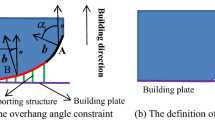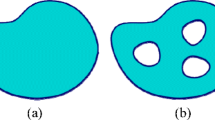Abstract
Additive manufacturing (AM) technologies, such as selective laser sintering (SLS) and fused deposition modeling (FDM), have become the powerful tools for direct manufacturing of complex parts. This breakthrough in manufacturing technology makes the fabrication of new geometrical features and multiple materials possible. Past researches on designs and design methods often focused on how to obtain desired functional performance of the structures or parts, specific manufacturing capabilities as well as manufacturing constraints of AM were neglected. However, the inherent constraints in AM processes should be taken into account in design process. In this paper, the enclosed voids, one type of manufacturing constraints of AM, are investigated. In mathematics, enclosed voids restriction expressed as the solid structure is simplyconnected. We propose an equivalent description of simply-connected constraint for avoiding enclosed voids in structures, named as virtual temperature method (VTM). In this method, suppose that the voids in structure are filled with a virtual heating material with high heat conductivity and solid areas are filled with another virtual material with low heat conductivity. Once the enclosed voids exist in structure, the maximum temperature value of structure will be very high. Based upon this method, the simplyconnected constraint is equivalent to maximum temperature constraint. And this method can be easily used to formulate the simply-connected constraint in topology optimization. The effectiveness of this description method is illustrated by several examples. Based upon topology optimization, an example of 3D cantilever beam is used to illustrate the trade-off between manufacturability and functionality. Moreover, the three optimized structures are fabricated by FDM technology to indicate further the necessity of considering the simply-connected constraint in design phase for AM.
Similar content being viewed by others
References
Kruth J P, Leu M C, Nakagawa T. Progress in additive manufacturing and rapid prototyping. CIRP Annals-Manufacturing Technology, 1998, 47(2): 525–540
Gibson I, Rosen D W, Stucker B. Additive Manufacturing Technologies. New York: Springer, 2010
Murr L E, Gaytan S M, Ramirez D A, et al. Metal fabrication by additive manufacturing using laser and electron beam melting technologies. Journal of Materials Science and Technology, 2012, 28(1): 1–14
Gu D, Meiners W, Wissenbach K, et al. Laser additive manufacturing of metallic components: Materials, processes and mechanisms. International Materials Reviews, 2012, 57(3): 133–164
Turner B N, Strong R, Gold S A. A review of melt extrusion additive manufacturing processes: I. Process design and modeling. Rapid Prototyping Journal, 2014, 20: 192–204
Kim D S, Bae S W, Choi K H. Development of industrial SFF system using dual laser and optimal process. Robotics and Computer-Integrated Manufacturing, 2007, 23(6): 659–666
Kruth J, Vandenbroucke B, van Vaerenbergh J, et al. Digital manufacturing of biocompatible metal frameworks for complex dental prostheses by means of SLS/SLM. In: Proceedings of Virtual Prototyping and Rapid Manufacturing-Advanced Research in Virtual and Rapid Prototyping, Taylor & Francis. London, 2005, 139–146
Rosen D. Design for additive manufacturing: Past, present, and future directions. Journal of Mechanical Design, 2014, 136(9): 090301
Sigmund O, Maute K. Topology optimization approaches. Structural and Multidisciplinary Optimization, 2013, 48(6): 1031–1055
Cheng K T, Olhoff N. An investigation concerning optimal design of solid elastic plates. International Journal of Solids and Structures, 1981, 17(3): 305–323
Bendsøe M P, Kikuchi N. Generating optimal topologies in structural design using a homogenization method. Computer Methods in Applied Mechanics and Engineering, 1988, 71(2): 197–224
Zhou M, Rozvany G. The COC algorithm, Part II: Topological, geometrical and generalized shape optimization. Computer Methods in Applied Mechanics and Engineering, 1991, 89(1–3): 309–336
Bendsøe M P, Sigmund O. Material interpolation schemes in topology optimization. Archive of Applied Mechanics, 1999, 69(9–10): 635–654
Allaire G, Jouve F, Toader A M. A level-set method for shape optimization. Comptes Rendus Mathematique, 2002, 334(12): 1125–1130
Wang M Y, Wang X, Guo D. A level set method for structural topology optimization. Computer Methods in Applied Mechanics and Engineering, 2003, 192(1–2): 227–246
Xie Y, Steven G P. A simple evolutionary procedure for structural optimization. Computers & Structures, 1993, 49(5): 885–896
Sokolowski J, Zochowski A. Topological derivative in shape optimization. In: Floudas C A, Pardalos P M, eds. Encyclopedia of Optimization. New York: Springer, 2009, 3908–3918
Sobieszczanski-Sobieski J, Haftka R T. Multidisciplinary aerospace design optimization: Survey of recent developments. Structural Optimization, 1997, 14(1): 1–23
Bendsoe M P, Sigmund O. Topology Optimization: Theory, Methods and Applications. Berlin: Springer, 2004
Zhang Y, Liu S. Design of conducting paths based on topology optimization. Heat and Mass Transfer, 2008, 44(10): 1217–1227
Zhu J, Zhang W, Beckers P. Integrated layout design of multicomponent system. International Journal for Numerical Methods in Engineering, 2009, 78(6): 631–651
Sigmund O. Tailoring materials with prescribed elastic properties. Mechanics of Materials, 1995, 20(4): 351–368
Nomura T, Nishiwaki S, Sato K, et al. Topology optimization for the design of periodic microstructures composed of electromagnetic materials. Finite Elements in Analysis and Design, 2009, 45(3): 210–226
Radman A, Huang X, Xie Y. Topological optimization for the design of microstructures of isotropic cellular materials. Engineering Optimization, 2013, 45(11): 1331–1348
Larsen U D, Sigmund O, Bouwstra S. Design and fabrication of compliant micromechanisms and structures with negative Poisson’s ratio. In: Proceedings of Micro Electro Mechanical Systems, the Ninth Annual International Workshop on an Investigation of Micro Structures, Sensors, Actuators, Machines and Systems. San Diego: IEEE, 1996, 365–371
Chen W, Liu S. Topology optimization of microstructures of viscoelastic damping materials for a prescribed shear modulus. Structural and Multidisciplinary Optimization, 2014, 50(2): 287–296
Andreassen E, Lazarov B S, Sigmund O. Design of manufacturable 3D extremal elastic microstructure. Mechanics of Materials, 2014, 69(1): 1–10
Brackett D, Ashcroft I, Hague R. A dithering based method to generate variable volume lattice cells for additive manufacturing. In: 22nd Annual international solid freeform fabrication symposium. 2011, 671–679
Aremu A, Ashcroft I, Hague R, et al. Suitability of SIMP and BESO topology optimization algorithms for additive manufacture. In: 21st Annual International Solid Freeform Fabrication Symposium (SFF)—An Additive Manufacturing Conference. 2010, 679–692
Gaynor A T, Meisel N A, Williams C B, et al. Multiple material topology optimization of compliant mechanisms created via polyJet 3D printing. Journal of Manufacturing Science and Engineering, 2014, 136(6): 061015
Hu Y, Blouin V Y, Fadel G M. Design for manufacturing of 3D heterogeneous objects with processing time consideration. Journal of Mechanical Design, 2008, 130(3): 031701
Tomlin M, Meyer J. Topology optimization of an additive layer manufactured (ALM) aerospace part. In: Proceedings of 7th Altair CAE Technology Conference. 2011
Vayre B, Vignat F, Villeneuve F. Designing for additive manufacturing. Procedia CIRP, 2012, 3: 632–637
Diegel O, Singamneni S, Reay S, et al. Tools for sustainable product design: Additive manufacturing. Journal of Sustainable Development, 2010, 3(3): 68–75
Kruth J P, Mercelis P, van Vaerenbergh J, et al. Binding mechanisms in selective laser sintering and selective laser melting. Rapid Prototyping Journal, 2005, 11(1): 26–36
Zein I, Hutmacher D W, Tan K C, et al. Fused deposition modeling of novel scaffold architectures for tissue engineering applications. Biomaterials, 2002, 23(4): 1169–1185
Hutmacher D W, Schantz T, Zein I, et al. Mechanical properties and cell cultural response of polycaprolactone scaffolds designed and fabricated via fused deposition modeling. Journal of Biomedical Materials Research, 2001, 55(2): 203–216
Myers S B. Connections between differential geometry and topology. I. Simply connected surfaces. Duke Mathematical Journal, 1935, 1(3): 376–391
Bondy J A, Murty U S R. Graph Theory with Applications. London: Macmillan, 1976
Golumbic MC. Algorithmic Graph Theory and Perfect Graphs. 2nd. North Holland, 2004
West D B. Introduction to Graph Theory. Upper Saddle River: Prentice hall, 2001
Korf R E. Depth-first iterative-deepening: An optimal admissible tree search. Artificial Intelligence, 1985, 27(1): 97–109
Zhou R, Hansen E A. Breadth-first heuristic search. Artificial Intelligence, 2006, 170(4–5): 385–408
Bader D A, Madduri K. Designing multithreaded algorithms for breadth-first search and st-connectivity on the Cray MTA-2. In: International Conference on Parallel Processing. Columbus: IEEE, 2006, 523–530
Gabow H N, Tarjan R E. A linear-time algorithm for a special case of disjoint set union. In: Proceedings of the Fifteenth Annual ACM Symposium on Theory of Computing. Baltimore: ACM, 1983, 246–251
Tarjan R E. Efficiency of a good but not linear set union algorithm. Journal of the ACM, 1975, 22(2): 215–225
Dhatt G, Lefrançois E, Touzot G. Finite Element Method. New York: John Wiley & Sons, 2012
Bathe K J. Finite element method. In: Wah B W, ed. Wiley encyclopedia of computer science and engineering. New York: John Wiley & Sons, 2008, 1–12
Raithby G, Chui E. A finite-volume method for predicting a radiant heat transfer in enclosures with participating media. Journal of Heat Transfer, 1990, 112(2): 415–423
Liszka T, Orkisz J. The finite difference method at arbitrary irregular grids and its application in applied mechanics. Computers & Structures, 1980, 11(1–2): 83–95
Author information
Authors and Affiliations
Corresponding author
Rights and permissions
About this article
Cite this article
Liu, S., Li, Q., Chen, W. et al. An identification method for enclosed voids restriction in manufacturability design for additive manufacturing structures. Front. Mech. Eng. 10, 126–137 (2015). https://doi.org/10.1007/s11465-015-0340-3
Received:
Accepted:
Published:
Issue Date:
DOI: https://doi.org/10.1007/s11465-015-0340-3




